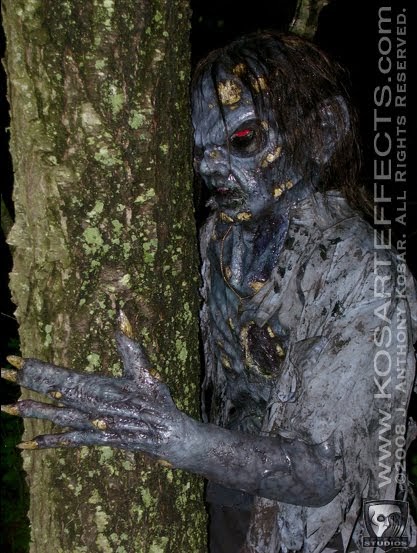

(Discussing “The Birds,” del Toro notes that “in the terror genre, an artist, unbound by ‘reality,’ can create his purest reflection of the world-the cinematic equivalent of poetry.”) In 1985, he launched Necropia, a special-effects company, making low-end bogeymen for films being shot in Mexico City. He attended a new film school, the Centro de Investigación y Estudios Cinematográficos, in Guadalajara, and after graduating, in 1983, he published a book-length essay on Alfred Hitchcock. “It looks messy, but it’s all sculpted.”)
THE RITUAL CREATURE MAQUETTE CRACKED
There is a photograph from this period of del Toro, now overweight, transformed into the melting corpse of a fat woman his eyeballs drip down his cheeks like cracked eggs. He loved working on special effects, and his experiments with makeup grew outlandish. In high school, he made a short about a monster that crawls out of a toilet and, finding humans repugnant, scuttles back to the sewers. (His favorite was Richard Corben, whose drawings, in magazines such as Heavy Metal, helped define underground comics: big fangs, bigger breasts.) So del Toro turned to film. Del Toro was a good draftsman, but he knew that he would never be a master. He began drawing creatures himself, consulting a graphic medical encyclopedia that his father, an unenthusiastic reader, had bought to fill his gentleman’s library. As a kid, I’d buy collodion in theatrical shops, and I’d scar my face and scare the nanny.”ĭel Toro filled his bedroom with comic books and figurines, but he was not content to remain a fanboy. “You put a line on your face, and it contracts and pulls the skin. “Collodion is material used to make scars,” he told me.

Susana’s neck has a dreadful gash, courtesy of makeup applied by her brother. Guillermo, then broomstick-thin, has added to his ensemble plastic vampire fangs, and his chin is goateed with fake blood. Del Toro has kept a family photograph of him and his sister, Susana, both under ten and forced into polyester finery. He raised a gothic menagerie: hundreds of snakes, a crow, and white rats that he sometimes snuggled with in bed. Federico built a Chrysler-dealership empire with the money, and moved the family into a white modernist mansion. Confounding his father became a lifelong project.īefore del Toro started school, his father won the Mexican national lottery. His mother, Guadalupe, an amateur poet who read tarot cards, was charmed his father, Federico, a businessman whom del Toro describes, fondly, as “the most unimaginative person on earth,” was confounded.

In a tape recording made when he was five, he can be heard requesting a Christmas present of a mandrake root, for the purpose of black magic. One of his first toys, which he still owns, was a plush werewolf that he sewed together with the help of a great-aunt. He bought it, and was so determined to decode Ackerman’s pun-strewed prose-the letters section was called Fang Mail-that he quickly became bilingual.ĭel Toro was a playfully morbid child. One day, in the magazine aisle of a supermarket, he came upon a copy of Famous Monsters of Filmland.

He liked to troll the city sewers and dissolve slugs with salt. In 1971, Guillermo del Toro, the film director, was a seven-year-old misfit in Guadalajara, Mexico. He crammed an eighteen-room house in Los Feliz with genre memorabilia, including a vampire cape worn by Bela Lugosi and a model of the pteranodon that tried to abscond with Fay Wray in “King Kong.” Ackerman eventually sold off his collection to pay medical bills, and in 2008 he died. Ackerman founded a cult magazine, Famous Monsters of Filmland, and, more lucratively, became an agent for horror and science-fiction writers. He started a group called the Boys’ Scientifiction Club in 1939, he wore an outer-space outfit to a convention for fantasy aficionados, establishing a costuming ritual still followed by the hordes at Comic-Con. By the time he reached the final page, he had become America’s first fanboy. In 1926, Forrest Ackerman, a nine-year-old misfit in Los Angeles, visited a newsstand and bought a copy of Amazing Stories-a new magazine about aliens, monsters, and other oddities.


 0 kommentar(er)
0 kommentar(er)
